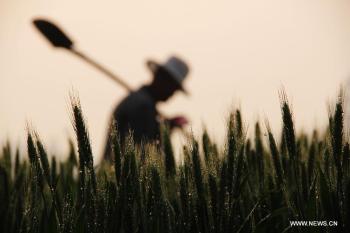Do you dig trenches or carry buckets?
by Morgan Webert
Have you ever done something with ease and then immediately after felt shocked and surprised because every time before felt like a struggle? Its as if suddenly, boom, there you are doing it and its no big deal!
While it might feel like that moment snuck up on you, more than likely you’ve been building up to it for a long time, slowly and diligently removing the obstacles that previously made it a struggle.
This removing of obstacles, Patanjali says in the last chapter of the Yoga Sutras, is the primary action of the focused yogi’s mind that reaches exceptional, super-human capabilities (YS 4.3). He goes on to liken this action of the “mind that remains with its object without distractions” to a farmer who cuts a dam to allow water to flow into the field where it’s needed.
In the most recent yoga anatomy lecture with Lesslie Kaminoff, he shared with us a parable inspired by this farmer metaphor. Kaminoff compares two types of farmers.
The first farmer carries two buckets on a stick across his back up the hill to a pond to fetch water for his fields. He does this day in and day out to keep his fields growing, just like his father did, and just like his son’s will do.
The second farmer, on the other hand, carries a shovel out into the fields and begins to dig trenches next to his plants and then laboriously digs a trench up the hill to the pond. When finally he makes it to the pond, he cuts the last bit of earth, lets the water flow to his fields and takes rests appreciating his good work.
The metaphor asks us to ponder the nature of our actions. Are they more like farmer one forever filling empty buckets one at a time, or more like farmer two, creating space so that water may flow from the source and continue to nourish the field long after the works been done to dig the trenches?
The yogic system understands that the energy of the world exists within us and all around us, we do not need to create that energy, its already there. Our job, and the task of our practice, is to decipher what stands in the way of that energy flowing optimally and then remove the obstacle.
We can draw this metaphor out into so many areas of life, but let’s have a look at how it relates to our breathing.
Firstly, when we practice asana (or any aspect of life really) and find ourselves holding our breath, it often indicates a state of stress, physical or mental. Physically it often happens when students strain to get into or hold a posture.
While holding the breath might temporarily give a sense of stability, control or deepening, it’s actually depriving your body of oxygen, bringing or keeping you in a state of stress and not sustainable. Practicing like this wont strengthen or open the body, nor will it teach focusing and calming the mind. Its like the first farmer forever hiking up the hill with his buckets.
 On the other hand, if a person learns to breath smoothly and fluidly through challenging poses (and moments of life), they will not only receive more oxygen to the brain and muscle tissue, but also learn to active the parasympathetic nervous system to calm the mind and find greater focus.
On the other hand, if a person learns to breath smoothly and fluidly through challenging poses (and moments of life), they will not only receive more oxygen to the brain and muscle tissue, but also learn to active the parasympathetic nervous system to calm the mind and find greater focus.
Cultivating these qualities will strengthen a yoga student both physically and mentally, making the inevitable challenges of life easier to deal with as they arise. Cultivating these characteristics and skills are like digging trenches up to the pond. You might not get the pose right away, the fields might stay dry while you’re digging, but eventually you know you’ll reach the point where you can sustain the posture with ease, deal with the mental challenge with a sense of ease, or water the field with ease.
So have patience and compassion with your struggles, but also be discerning, and dig those trenches to the source!

